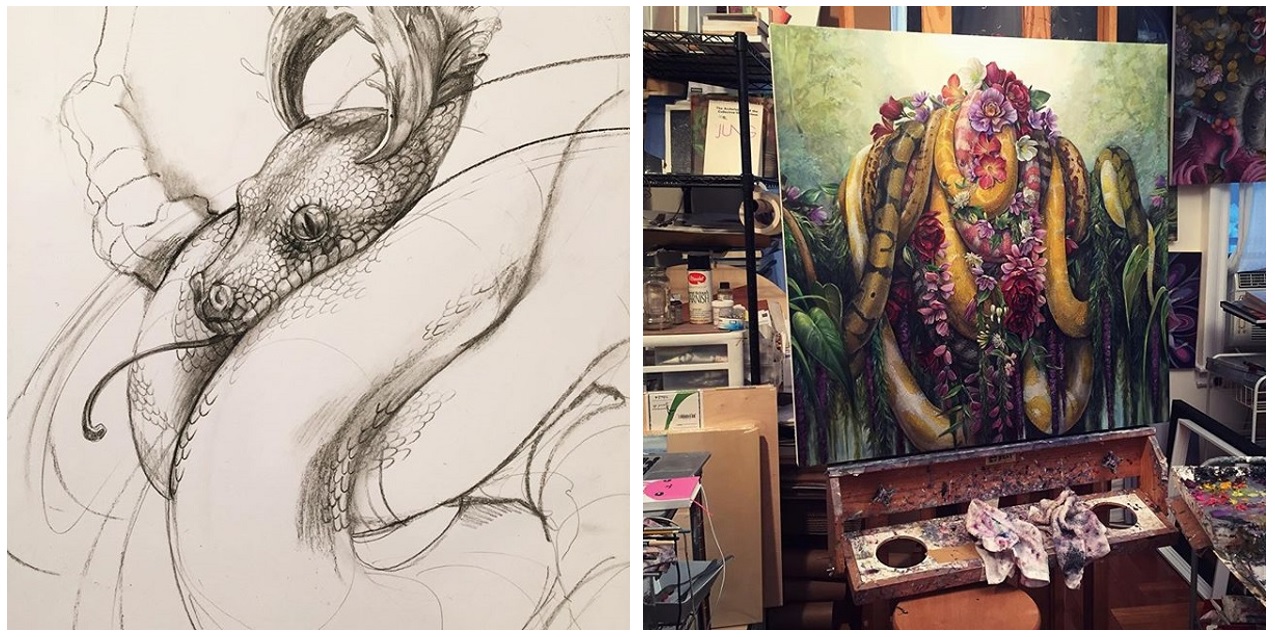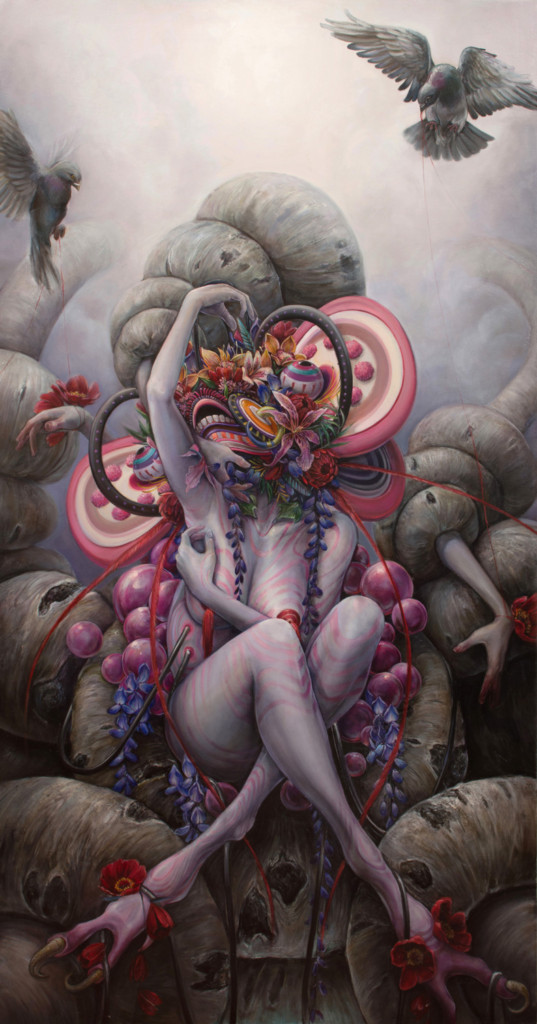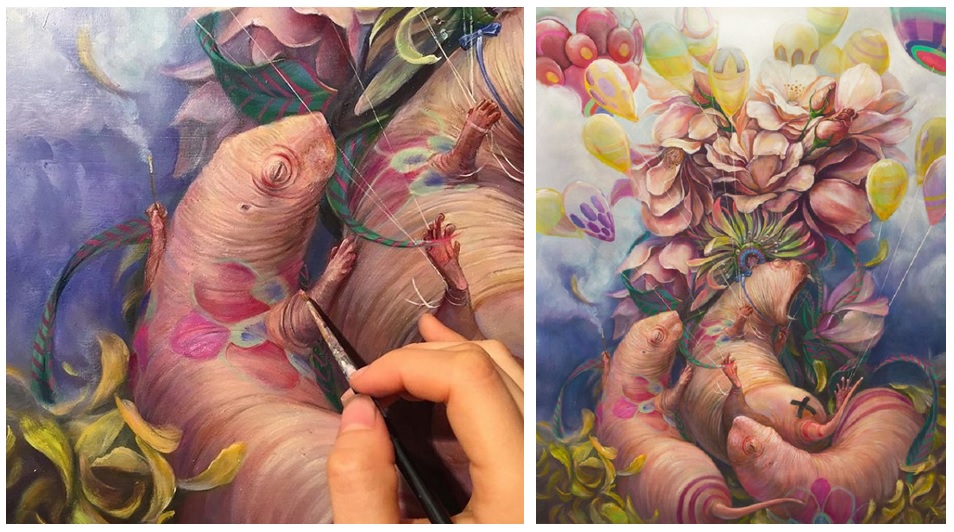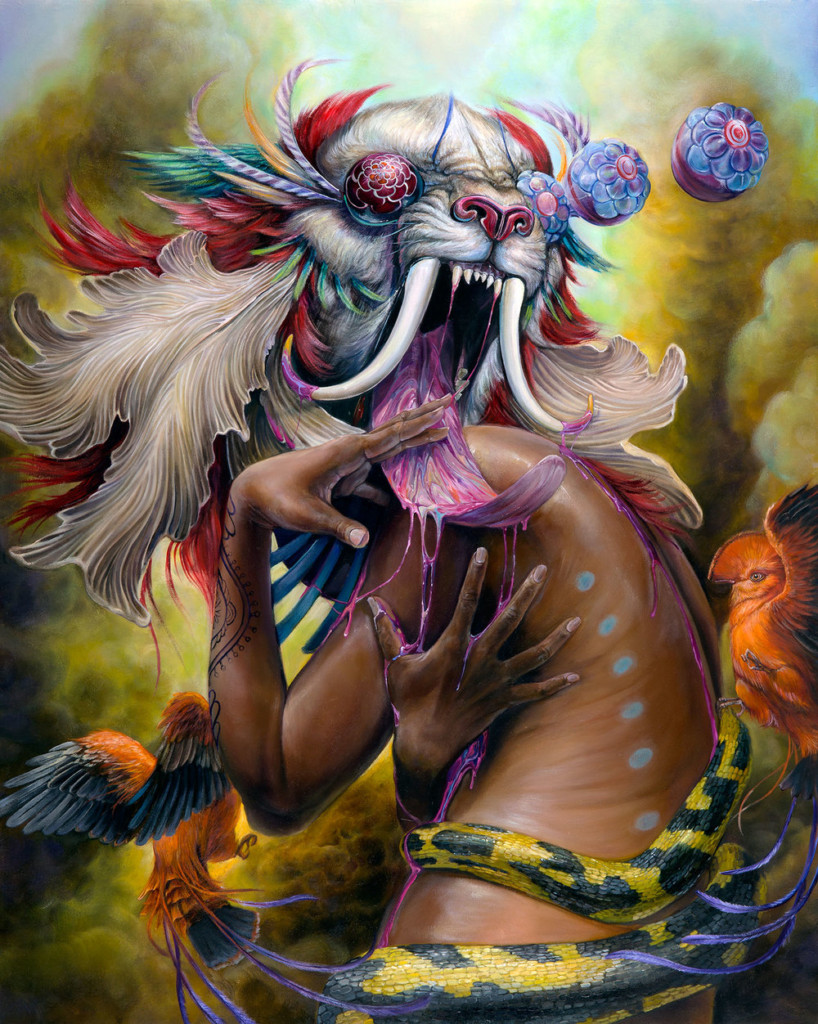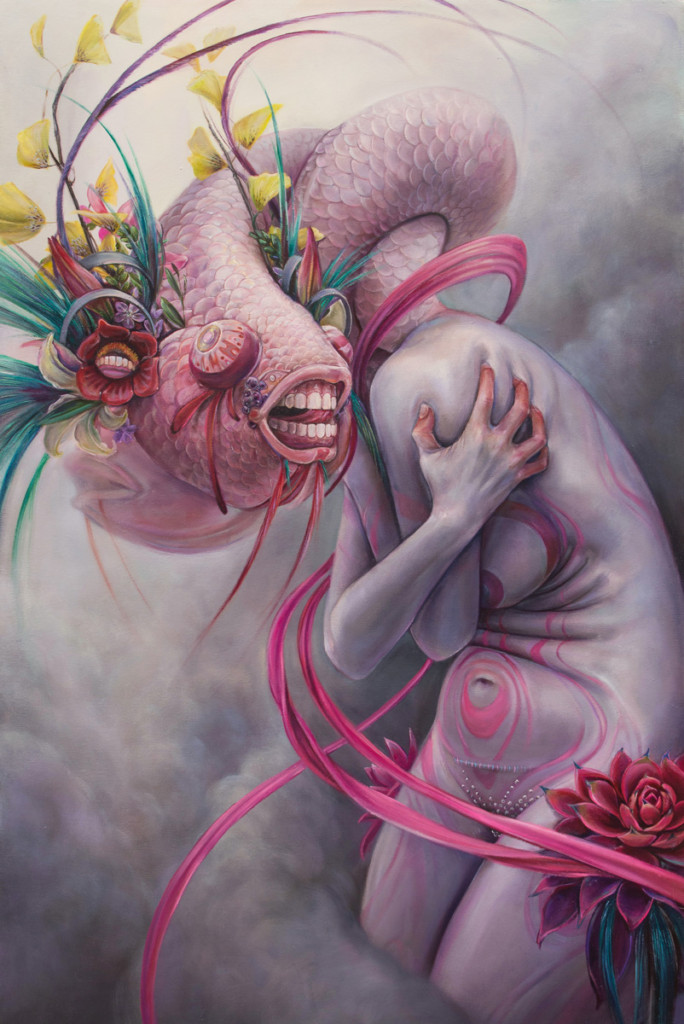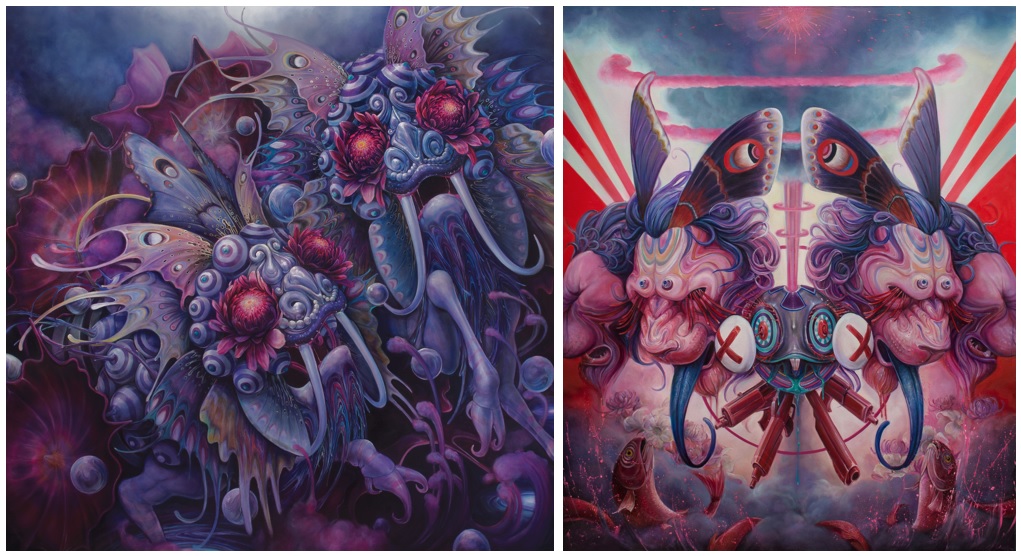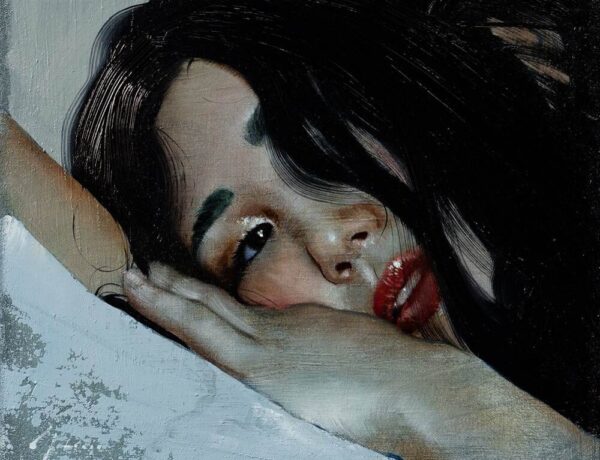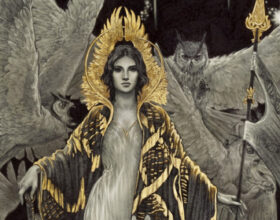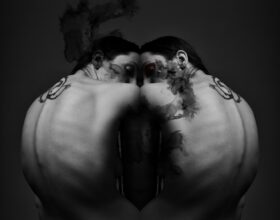Rainbows of vibrant colors drip and sway in NYC artist Hannah Faith Yata’s oil paintings. Dealing with the topics of feminism and environmentalism, Yata’s work often depicts faceless women; their heads replaced with a variety of animal heads such as fish and lions, and are concealed under tribal masks that burst in color. Subjects frequently froth and salivate from the mouth, eyes and genitals covered with X’s. These large works have become increasingly psychedelic in recent years, as Hannah describes they reflect the increasingly tense world.
Issues on women’s rights and atmospheric pollution are a strong theme amongst all of Hannah Faith Yata’s artwork. Hannah’s strong feelings about objectification of women and damage done to the earth by communities come through even stronger via her smooth, fantasy-and sometimes realistic- subjects. Her research on these topics leads to chaotic compositions that desperately shout out against these issues, attempting to connect society back to Nature and create equality in both the senses of all living things being as important as humans, and women’s voices being heard just as loudly as men’s.
Please enjoy this exclusive interview with Hannah Faith Yata that delves more deeply into her work.
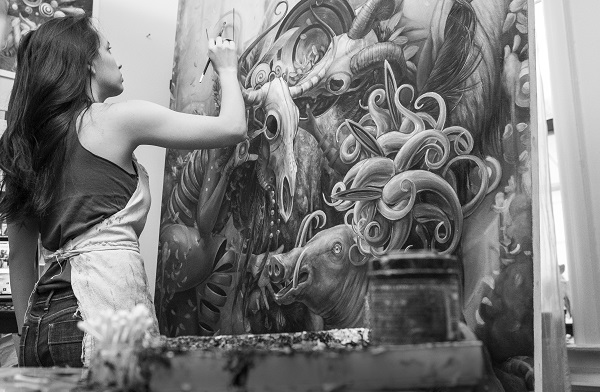
Hannah Faith Yata
Facebook | Web | Instagram | Twitter
Your more recent work explodes with color, while your later work seems more muted in comparison. Would you like to talk about this evolution, and maybe how you want to continue to evolve?
Yes, this evolving- I see it in hindsight as maturing. It wasn’t a conscious decision to say “hey my work should be brighter-“ I think it’s an evolution of ideas and thinking patterns. The pendulum between swinging from a more muted color palette to a brighter one has honestly brought me to this ground where I understand color now like one might understand mixing chemicals; you put certain colors together and things start to bubble and maybe explode. I feel like this year I’ve started to see the fine balance of color.
Really, I can also attribute that to ideas I see about my work… I think I start to see things more holistically. Doing the research and reading the books is like a spiral- something that keeps winding around and connecting into larger themes in the universe. Subtleties and nuances emerge, your brain becomes to understand the hidden strings and the reflected shadows at play. I’ve started to think it starts to make its way into the paint as well.
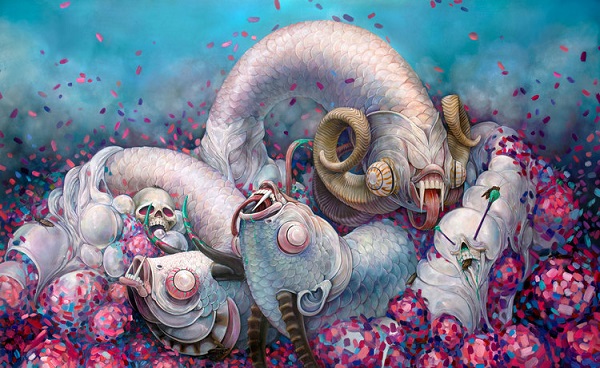
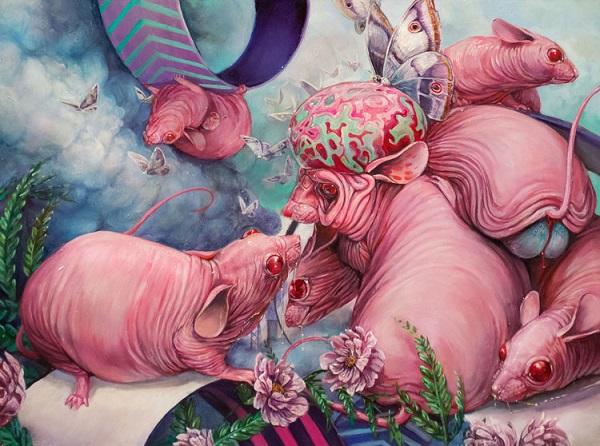
People see the same color differently; three people can look at the same shade of red, yet they all see a different red. You relate the psychedelic parts of your work to nature’s energy. Is this how you see nature and your surroundings, in bright colors? Do you feel vibrations/emotion in color?
I can only describe my affinity for color as reading something: to relay to the other viewers the same way it ignites my brain and sends my adrenaline pumping. I feel like I am a translator of feelings onto canvas with shapes and color. I do feel these emotions in color, but really to the extent that I’m able to translate that in paint.
I believe when I look at a painting by one of the Hudson River School painters like Frederic Edwin Church and Thomas Cole – I feel that nature really ignited a sort of passion they had for life and energy. They wanted to capture it and relay it to the world in way that was breaking away from just a simple landscape painting- they brought in bright cadmiums, succulent blues and greens, and tumultuous undulations of mountains and clouds. They were criticized for not painting more realistically in their time, but we look at it today and we see this incredible breath taking beauty. What they were doing, they weren’t trying to just capture something from life, they were trying to capture energy. I believe capturing energy means breaking certain rules.
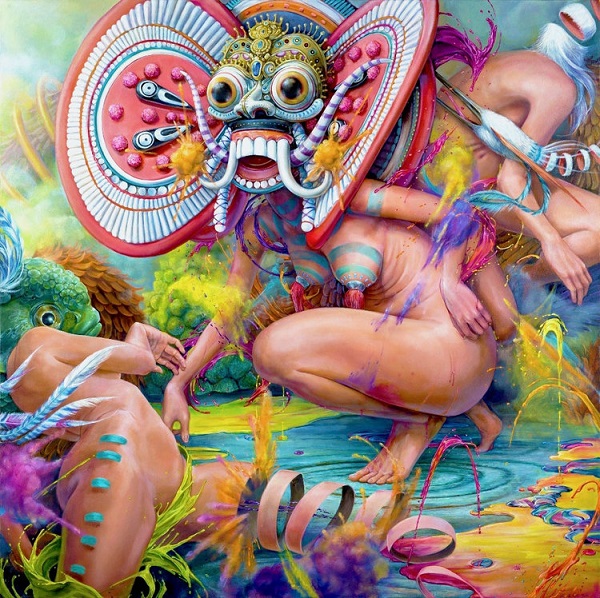
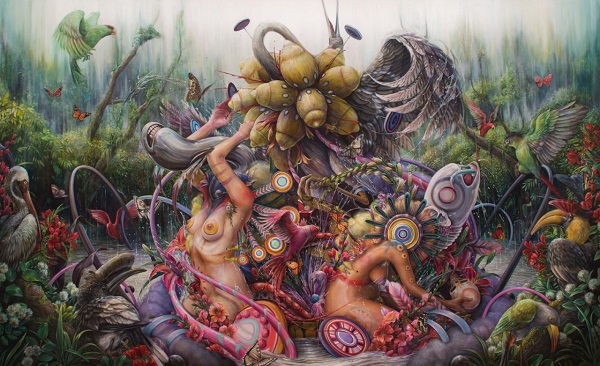
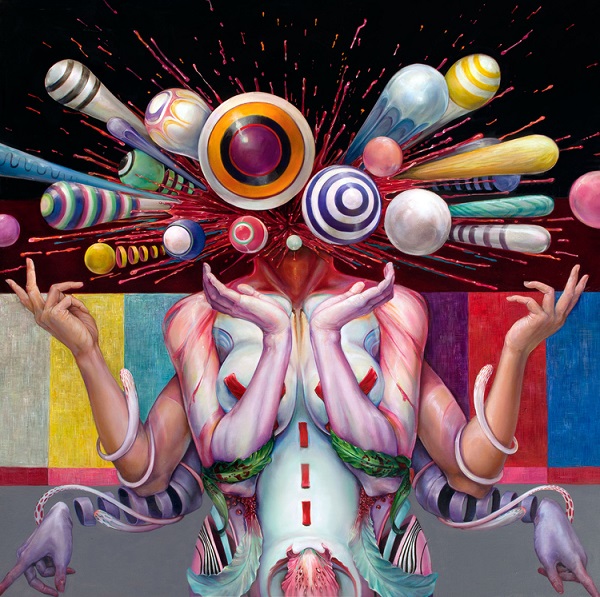
A college class opened your eyes to feminism and the history of using the woman figure in art as a metaphor for nature. Do you feel that your paintings impact people’s perspectives on environmental issues and feminism?
I honestly don’t know if my paintings really make sense to most people on a conscious level. To me, I find that a lot of things seem to resonate on a subconscious level- like a lot of people tell me my work is titillating to their psyche but they’re not quite sure why. That’s generally satisfying, because I know if people really want to find out what the work is about it tends to be pretty easy with a little research.
I think in the beginning I was more aggressive with my ideas. I really wanted people to know something- I guess you could say it was driven by frustration. Now I realize that that’s not how I want to relate to people or I want people to relate to me.
We all make up our own stories when it comes to the shadows on the wall. I think that’s the power of art versus an advertisement or an illustration; it’s more about how it relates to us individually, and if people want to find out more about the idea and where the artist is coming from, the information is accessible. Ideally, I would love if people opened their mind to all the perspectives: how they relate to it and what it reflects in themselves, the layers of stories, philosophy, psychology behind the paintings, and the artist’s intention.
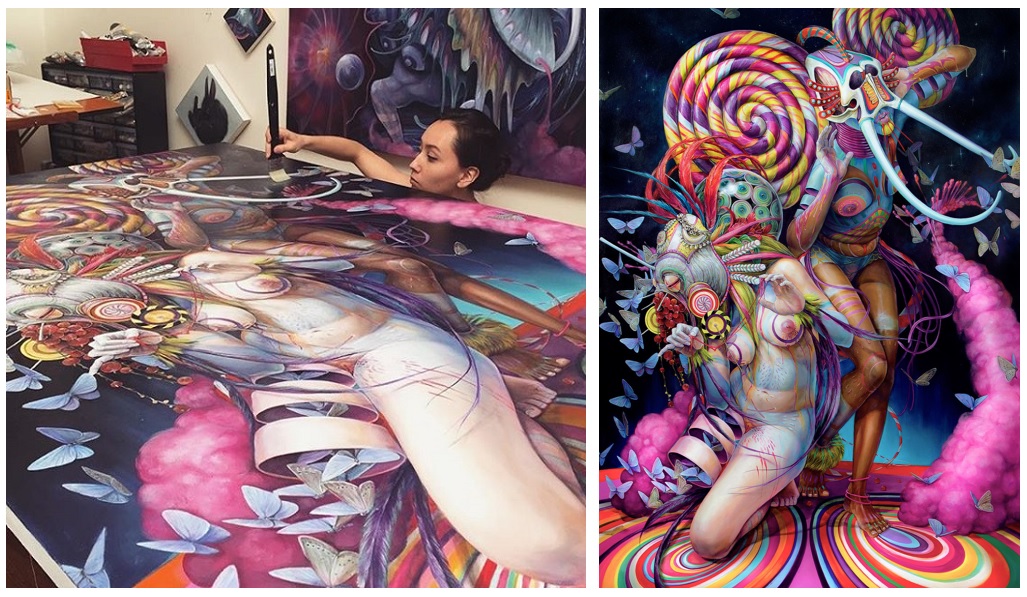
You haven’t interacted with your mother for about 10 years because of religious differences. I could point out how I think this tumultuous relationship comes out in your art, but how do you think you express this estrangement through your work?
Ah, interesting question. This is a topic I’ve thought about many times, and many different angles. Her influence on my life growing up but also being isolated from her from so long has brought with it a variety of emotions.
As I grew older and out of a teenage angst I began to meditate on the social and religious influences imposed upon her and how those frustrations played out towards me. I realized the more I talked to people about these issues (and not my mother in particular) everyone has struggled with the same things in some sort of way.
In my mother’s case, there was always this unspoken shame. When she got pregnant with each of us, she always thought she would have a boy each time. Going through my rebellious phase as a young adult and leaving her religion was the ultimate shame, especially after getting a divorce from our dad. I was the black mark on her good mother card. We, as her daughters, were supposed to remain untouched until marriage, not to mention abstain from any other nefarious activities, and I broke all those rules.
We fought constantly, and in efforts to get me to see things her way she would handpick psychologists that understood the facets of her religion and supported her pressure to go back. Not able to get a word in edgewise, I felt increasingly powerless and furious.
I should’ve realized it was a fight I wouldn’t win, and that fighting was just making her more entrenched in her own way of thinking. Yet, I see it everywhere, the same patterns reemerging one generation to the next: broken people, breaking people, which break things and wreck havoc on the planet.
I realized the authentic self was the one hiding behind so many masks, so many faces that would never see the light of day. So many people, even fundamentalists like my mother, dying to get out and live freely but they had all become self-enslaved, and in turn wanted to chain their children to the same ideas.
So the fish head became the original mask and I became familiar with: something a part of nature yet so numb in expression. The blank expression reflected my own struggles with feeling brainwashed and insecure. I put her on a body and celebrated that body instead of feeling embarrassment for it. She became to have other emotions, she grew to encompass other spirit animals and other masks. She was the woman: the scorned, the joyful, the rebellious. She is the energy and emotion of life. The life that is wild and beautiful in a world that wants to impose destruction, sameness, and enslavement upon her.
I have noticed that your pet bunny shows up in a few of your pieces. Does this hold a particular significance?
Haha, the rabbit something I love as a symbol and as an idea. Yes, I own rabbits and they have incredible personalities and love to demolish things, but I saw this little cartoon once and it was this guy in a business suit chastising a group of rabbits saying “You overpopulate and destroy everything!” while plumes of smoke rise from a large factory in a back ground. I laughed at it but the deeper irony stayed with me: to me, the idea that we believe that certain animals (rabbits for instance), overpopulate and destroy everything is an incredible hypocrisy- I feel like the natural world looks at our species and says the same thing as the man in the suit. No matter how many rabbits might overpopulate, the earth has a way of eventually balancing itself out. Humans, on the other hand, have ensured their own survival and keep repopulating at alarming rates. So rabbits, as a symbol, became a stand-in cheeky metaphor for humans and our tendency for fucking and destructive tendencies.
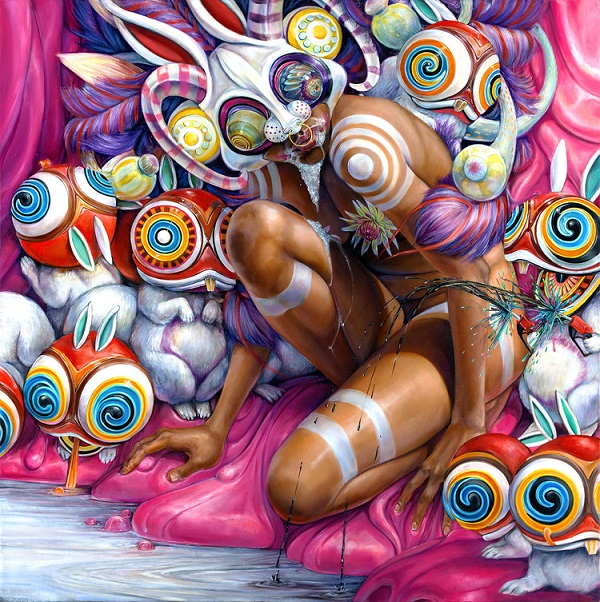
You mentioned in a previous interview that Carl Jung, Ernest Becke, and Francis Bacon inspired you, do they still or who are your current idols?
Yes! They definitely still inspire me- some of the latest authors and thinkers I’ve really enjoyed is Paul Hawken, Eric Fromm, Paul Shepard, and revisiting some of Sigmund Freud’s less popular work.
Paul Shepard and Eric Fromm especially hit home with me with their books like “Nature and Madness” and “The Sane Society.” I feel like understanding how we got to this point is not as easy to find as one might think- but incredibly necessary if we want learn from our mistakes. The industrial paradigm breeds an unnatural neurosis with our divorce from nature and the spiritual disconnection we have from earth. I think we get so wrapped up in movements or political agendas: fighting this, helping that- we forget to analyze ourselves: our way of life, and why certain things are so appealing to us and why we are so influenced by certain imagery or ideas. Without analyzing the framework of our being- our psycho-history and own human ecology- we will never stop our endless cycle of consuming what beautiful world we have left no matter what kind of government is in place.
You research a lot on environmental issues….what’s your next step forward against these issues? In what ways do you think other artists can contribute to this cause?
It’s very hard figuring out where you can effectively take the next step forward. Our system is built on destroying life in the name of “progress” but constantly trying to keep us in fear so we leave our heads down. Real progress is stifled when a car that runs on water is invented but then production is stifled when the inventor disappears, or the company is bought out by an oil company.
The upside is there are more and more grassroots movements that are springing up all over the place. People are waking up to the fact that a lot of the massive charities aren’t giving the donated money where it really should be going, so people are starting their own companies and charities.
My husband and I are deeply in love with the Rain Forest, and he has connections to some people in Ecuador that are protesting against the oil companies over there. I think the next step for us is to find a cheaper place to live and figure out ways to help their cause- whether it’s fighting in court or giving them other money and tools to fight for their land. We plan on visiting soon to talk to local tribes where there is deforestation and oil companies setting up shop.
For other artists, I just urge them to do their research. I think the beautiful thing about art is that it can be powerful if done the right way. Visual artists, musicians, and performers are now realizing they have a voice, especially with the advent of the internet- and I hope that voice can help open the minds of some people before more of our free speech is taken away.
Check out below this fabulous video by Trekell Art Supplies | Video produced by Jordan Ahern.


